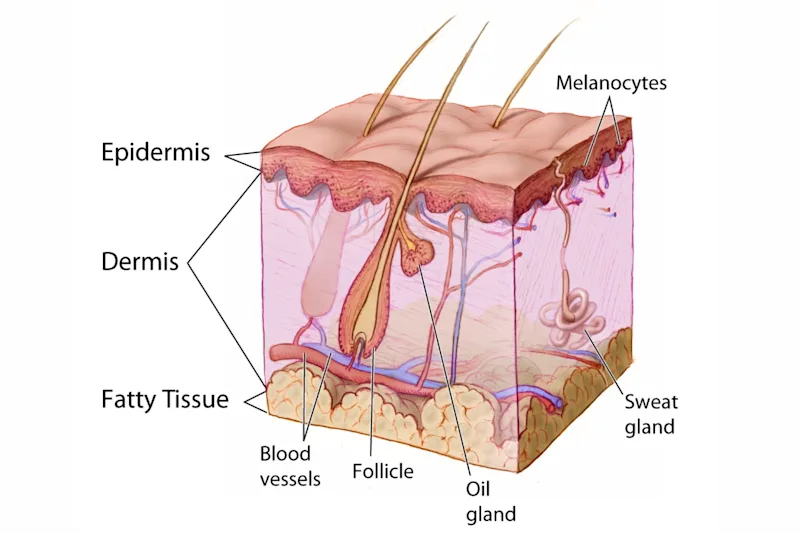Oily Skin - What Is It and Why Do I Have It?
No matter if you have oily skin, dry skin or a combination skin, it is important to first understand the basics of how the skin works. The skin is made of three main layers: the epidermis, the dermis, and the hypodermis (also known as the subcutaneous layer). The epidermis is the top layer of the skin that you’re able to see. This layer contains melanocytes that produce the pigment melanin, giving each of us our own unique skin tone. The dermis is the second layer, found under the epidermis, and it contains elements such as hair follicles, connective tissue, sebaceous glands, and sweat glands. The third layer, the hypodermis, is a layer of tissue and fat.

Source: https://commons.wikimedia.org
When it comes to oily skin, the layer of skin in which people tend to place their focus is the epidermis because it is what we physically see and can feel but the production of this oil is done so in the second layer of the skin—the dermis. Within the pores of the skin are hair follicles and attached to every hair follicle is a sac-like gland known as the sebaceous gland that produces sebum (an oil-like substance).
Sebaceous glands secrete sebum onto the epidermis layer of the skin. This oily substance is made up of fatty acids, waxes, and sugars. Most sebaceous glands are found on the face, while many others are found on the neck and the upper back and chest area. It is no coincidence that these are also the areas where breakouts tend to occur the most. Sebum is produced through a hormonal process called holocrine secretion. The sebaceous glands are regulated by hormones, namely testosterone which is found in humans of every gender. As a result, people who experience hormonal changes or imbalances oftentime also experience changes to their skin. This is why teenagers going through puberty, pregnant women, and women experiencing fluctuating hormonal levels during the menstrual cycle are often faced with acne breakouts [1]. Adolescents are particularly susceptible, as sebum production may increase up to 500 percent during pubescence.
Sebum is released onto the epidermis in order to lubricate and water-proof the skin. It creates a protective barrier that not only seals in moisture and electrolytes, preventing water loss, but also aids in the prevention of infection. Because sebum is slightly acidic, with a pH of 4.5-6, it offers the skin a defensive shield against bacteria, viruses, microbes, and other pathogens. Additionally, the moisture provided to the skin by sebum prevents drying and cracking which could also lead to skin infection. Squalene, one of the largest components found in sebum, also helps to protect the skin against the damage caused by the sun’s UV rays.
There are several problems associated with the overproduction of sebum that causes oily skin. One of the most obvious issues with excess sebum is enlarged pores. When sebaceous glands release oil, the oil rises to the top layer of the skin, the dermis, and collects in the pore, causing the pore to appear larger. Acne can be another result of excess sebum production, though everyone with oily skin will not necessarily face problems with acne. Around eighty-five percent of people experience acne [2] at some point during their lifetime and there are many factors [3] that cause and contribute to having oily skin including genetics, stress, hormonal fluctuation, dietary sensitivities, and environmental factors.
When excess sebum and dead skin cells get trapped beneath the pore’s surface, referred to as a skin “plug,” bacteria that typically lives on the surface of your skin without causing any harm can begin to grow within the follicle, causing inflammation [4]. Cutibacterium acnes, also known as C. acnes, is a slow growing bacteria linked to the acne skin condition that feeds off of the oil on the face, leaving behind inflammatory particles. These types of inflammation on the face can both lead to acne and breakouts.
Benefits of Having Oily Skin
Having oily skin also has its benefits. Sebum production slows as we age, causing the skin to grow thinner over time. However, oily skin tends to be thicker and therefore, signs of aging [5] tend to appear later than someone with dry, thin skin, with the exception of the eye area. Another advantage to having oily skin or thick skin is that it is more resistant to bruising, tears, cuts, and other abrasions.
If you are concerned about the amount of oil your skin is producing or if you’re struggling with acne or other breakouts, be sure to consult a board-certified dermatologist.